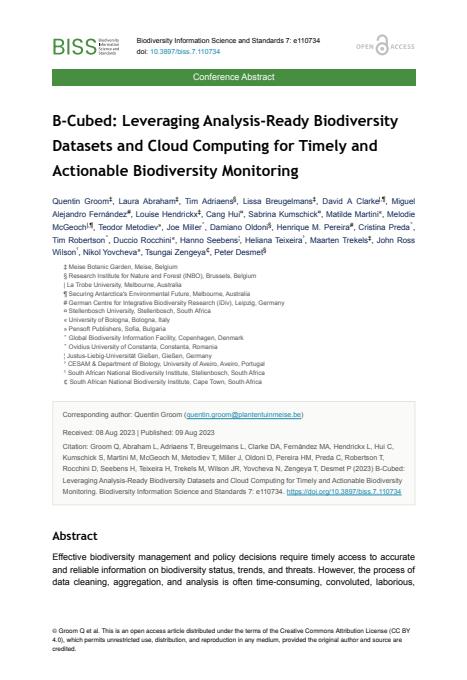B-Cubed: Leveraging analysis-ready biodiversity datasets and cloud computing for timely and actionable biodiversity monitoring
Details
| Number of pages | 3 |
|---|---|
| Pages (to-from) | 1-3 |
| Type | Paper/Powerpoint/Abstract |
| Category | Research |
| Language | English |
Bibtex
@misc{4790b3b8-d489-41ac-ae6b-9f05f525cfea,
title = "B-Cubed: Leveraging analysis-ready biodiversity datasets and cloud computing for timely and actionable biodiversity monitoring",
abstract = "Effective biodiversity management and policy decisions require timely access to accurate and reliable information on biodiversity status, trends, and threats. However, the process of data cleaning, aggregation, and analysis is often time-consuming, convoluted, laborious, and irreproducible. Biodiversity monitoring across large areas faces challenges in evaluating data completeness and quantifying sampling effort. Despite these obstacles, unprecedented amounts of biodiversity data are being accumulated from diverse sources, aided by emerging technologies such as automatic sensors, eDNA, and satellite tracking.To address these challenges, the development of tools and infrastructure is crucial for meaningful interpretations and deeper understanding of biodiversity data (Kissling et al. 2017). Furthermore, a significant delay exists in converting biodiversity data into actionable knowledge. Efforts have been made to reduce this lag through rapid mobilisation of biodiversity observations, digitization of collections (Nelson and Ellis 2018), and streamlined workflows for data publication (Reyserhove et al. 2020). However, delays still occur in the analysis, publication, and dissemination of data.The B-Cubed project (Biodiversity Building Blocks for Policy)*1 proposes solutions to overcome these challenges. It implements the concept of Occurrence Cubes (Oldoni et al. 2020), which aggregate occurrence data along spatial, temporal and taxonomic dimensions. Cube generation will be available as a new service provided by the Global Biodiversity Information Facility (GBIF). By leveraging aggregated occupancy cubes as analysis-ready biodiversity datasets, we aim to enhance comprehension and reduce barriers to accessing and interpreting biodiversity data. Automation of workflows will provide regular and reproducible indicators and models that are open and useful to users. Additionally, the use of cloud computing offers scalability, flexibility, and collaborative opportunities for applying advanced data science techniques anywhere. Finally, close collaboration with stakeholders will inform us of the requirements for tools, increase impact, and facilitate the flow of information from primary data to the decision-making processes.",
author = "Quentin Groom and Laura Abraham and Tim Adriaens and Lissa Breugelmans and David A Clarke and Miguel Alejandro Fernández and Louise Hendrickx and Cang Hui and Sabrina Kumschick and Matilde Martini and Melodie A McGeoch and Teodor Metodiev and Joe Miller and Damiano Oldoni and Henrique M. Pereira and Cristina Preda and Tim Robertson and Duccio Rocchini and Hanno Seebens and Heliana Teixeira and Maarten Trekels and John Ross Wilson and Nikol Yovcheva and Tsungai Zengeya and Peter Desmet",
year = "2023",
month = aug,
day = "09",
doi = "https://doi.org/10.3897/biss.7.110734",
language = "English",
publisher = "Instituut voor Natuur- en Bosonderzoek",
address = "Belgium,
type = "Other"
}
Authors
Quentin GroomLaura Abraham
Tim Adriaens
Lissa Breugelmans
David A Clarke
Miguel Alejandro Fernández
Louise Hendrickx
Cang Hui
Sabrina Kumschick
Matilde Martini
Melodie A McGeoch
Teodor Metodiev
Joe Miller
Damiano Oldoni
Henrique M. Pereira
Cristina Preda
Tim Robertson
Duccio Rocchini
Hanno Seebens
Heliana Teixeira
Maarten Trekels
John Ross Wilson
Nikol Yovcheva
Tsungai Zengeya
Peter Desmet

